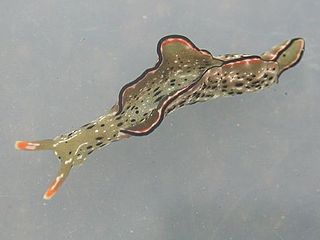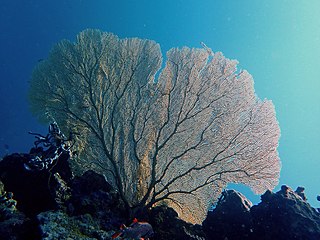
Zoanthids are an order of cnidarians commonly found in coral reefs, the deep sea and many other marine environments around the world. These animals come in a variety of different colonizing formations and in numerous different colors. They can be found as individual polyps, attached by a fleshy stolon or a mat that can be created from small pieces of sediment, sand and rock. The term "zoanthid" refers to all animals within this order Zoantharia, and should not be confused with "Zoanthus", which is one genus within Zoantharia.

Heteroconchia is a taxonomic infraclass of saltwater clams, marine bivalve molluscs, belonging to the subclass Autobranchia
The Podocopida are an order of ostracods in the subclass Podocopa. It is the most diverse of the four orders of ostracods, and also has a rich fossil record.
Polycopidae is a superfamily of marine ostracods. It is the only superfamily in the suborder Cladocopina.

Elysia ornata, commonly known as ornate elysia or ornate leaf slug, is a species of sea slug, a marine gastropod mollusk. This sea slug superficially resembles a nudibranch, yet it does not belong to that suborder of gastropods. Instead it is a member of the closely related clade Sacoglossa, the "sap-sucking" sea slugs.
The World Register of Marine Species (WoRMS) is a taxonomic database that aims to provide an authoritative and comprehensive list of names of marine organisms.
The Microcerberidea are a suborder of isopod crustaceans. They are less than 2 mm (0.079 in) long, and live interstitially. They may be found in the eastern Pacific Ocean, and around the coasts of South America, Africa, the Mediterranean Sea, and India.
The Calabozoidae are a family of freshwater isopod crustaceans in suborder Calabozoidea. It comprises two genera, Calabazoa and Pongycarcina.
The Microcerberidae are a family of isopod crustaceans. They are less than 2 mm (0.079 in) long, and live interstitially in shallow marine or freshwater sand habitats.

Cymothoida is the name of a suborder of isopod crustaceans with a mostly carnivorous or parasitic lifestyle. It contains more than 2,700 described species in four superfamilies. Members of the suborder are characterised by their specialised mouthparts which include a mandible with a tooth-like process which is adapted for cutting or slicing.

Sphaeromatidea is a suborder of isopod crustaceans, comprising the following superfamilies and families:

Scleraxonia is a suborder of corals, a member of the phylum Cnidaria.
The Calabozoidea or Calabozoida are a suborder of freshwater isopod crustaceans.

Spionida is an order of marine polychaete worms in the infraclass Canalipalpata. Spionids are cosmopolitan and live in soft substrates in the littoral or neritic zones.
Cypridoidea is a superfamily of ostracods in the suborder Cypridocopina.

Tubulariidae is a family of hydroid cnidarians. For long placed in a presumed superfamily or infraorder Tubulariida of suborder Capitata, they are actually close relatives of the Hydridae and are now united with these and a number of relatives in a newly recognized suborder Aplanulata. Most if not all species in this family grow on stalks and resemble small flowers.

Capitata is a suborder of Hydrozoa, a class of marine invertebrates belonging to the phylum Cnidaria.

Filifera is a suborder of hydrozoans in the order Anthoathecata. They are found in marine, brackish and freshwater habitats.

Echiuridae is a family of spoon worms in the suborder Echiurida. It is a monotypic family, the only genus being Echiurus. These worms burrow into soft sediment on the seabed.
Victorelloidea is a superfamily of bryozoans belonging to the order Ctenostomatida. It is the only superfamily in its monotypic suborder, Victorellina.










